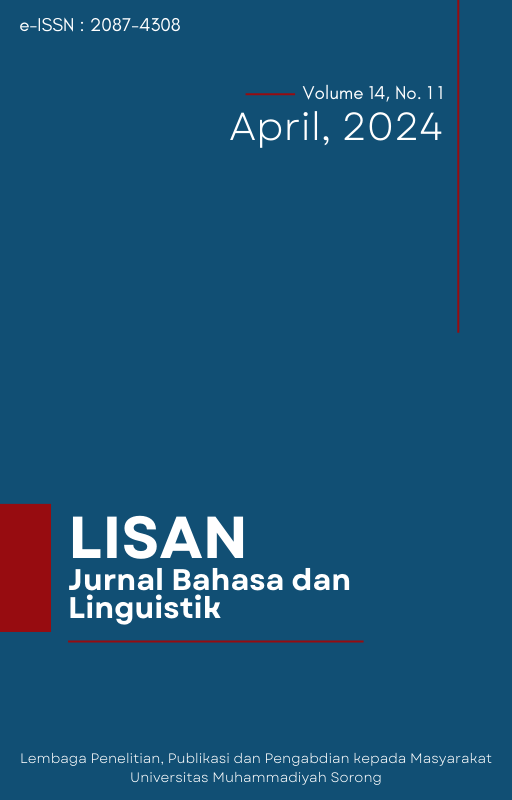Foreign Language Classroom Anxiety, and Enjoyment During Study Abroad: A Review of Selected Paper
DOI:
https://doi.org/10.33506/jbl.v8i2.367Abstract
From as simple as speaking up to speaking in public, from finishing a test to studying abroad, anxiety is historically a negative variable affecting many language learners. This paper reviews one of the latest research articles purposively involving anxiety, second language acquisition, and studying abroad written by Dewey, D. P., Belnap, R. K., & Steffen, P. (2018), entitled “Anxiety: Stress, Foreign Language Classroom Anxiety, and Enjoyment During Study Abroad in Amman, Jordan.†This study conducted in Jordan is a follow up to all the authors’ project in 2016 with participants who are beneficiaries of a quarter of a century experimentation. This present paper did not adequately funneled its aims but excellently analyzed previous literature’s and its own research design in a way that the average reader would understand, linking its findings with previous literature’s findings to give vivid seminal and contemporary context so despite the inconsistent flow. Moreover, this article’s content is valid (as all references are accurate) and well-argued. Not only is it highly recommended for its innovative anxiety-measure, but also because this research explored three gaps in anxiety and SLA studies: anxiety and L2 development in communicative environment (outside of classroom) abroad, degree of anxiety after receiving interventions to cope with anxiety, and anxiety levels in positive situation (enjoyable classroom). The research found despite levels of classroom enjoyment increasing, learners still show physiological signs of increased anxiety levels, more so if they have the tendency toward anxiety and low proficiency score prior to SA. Therefore this paper seen anxiety as a physiological conditions on “worry about an event†(p. 2), which makes this study believes that anxiety in language education context is an emotional state in which learners’ feel negative about their knowledge and skill in their language performance.References
Allen, H. W., & Herron, C. (2003). A mixed-methodology investigation of the linguistic and affective outcomes of summer study abroad. Foreign Language Annals, 36(3), 370–385.
Bakkane Bendixen, A., Engedal, K., Selbæk, G., Benth, J. Å ., & Hartberg, C. B. (2019). Anxiety symptom levels are persistent in older adults with a mental disorder: a 33 months followâ€up study — International Journal of Geriatric Psychiatry.
Ball, S. (2012). The Complete Guide to Writing your Dissertation: Advice, Techniques and Insights to help you enhance your grades. Hachette UK.
Belnap, R. K., Bown, J., Dewey, D. P., Belnap, L., & Steffen, P. (2016). Project perseverance: Helping students become self-regulating learners. In T. Gregersen, P. MacIntyre, & S. Mercer (Eds.), Positive psychology in SLA (pp. 282–301). Bristol, UK: Multilingual Matters.
Bown, J., Dewey, D., & Belnap, R. K. (2015). Student interactions during study abroad in Jordan. In R. Mitchell, N. Tracy-Ventura, & K. McManus (Eds.), Social interaction, identity and language learning during residence abroad. Eurosla Monographs Series, 4, 199–222.
Brantmeier, C. (2005). Anxiety about L2 reading or L2 reading tasks? A study with advanced language learners. Reading, 5(2), 67-85.
Chukhraev, N., Vladimirov, A., Zukow, W., Chukhraiyeva, O., & Levkovskaya, V. (2017). Combined physiotherapy of anxiety and depression disorders in dorsopathy patients. Journal of Physical Education and Sport, 17(1), 414.
Cohen, J. (1988). Statistical power analyses for the social sciences. Hillsdale, NJ: Erlbaum.
Dewaele, J. M., & MacIntyre, P. D. (2014). The two faces of Janus? Anxiety and enjoyment in the foreign language classroom. Studies in Second Language Learning and Teaching, 4(2), 237–274.
Green, J. M., & Oxford, R. (1995). A closer look at learning strategies, L2 proficiency, and gender. TESOL quarterly, 29(2), 261-297.
Heppner, P. P., & Heppner, M. J. (2004). Writing and publishing your thesis, dissertation, and research: A guide for students in the helping professions (Research, statistics, & program evaluation). Columbia, Missouri: Cengage Learning.
Kierkegaard, Søren. (1844). The Concept of Anxiety: A Simple Psychologically Orienting Deliberation on the Dogmatic Issue of Hereditary Sin. Denmark: Princeton University Press.
Lane, D. M., Scott, D., Hebl, M., Guerra, R., Osherson, D., & Zimmer, H. (2017). An Introduction to Statistics. Rice University.
MacIntyre, P. D. (2017). An overview of language anxiety research and trends in its development. New insights into language anxiety: Theory, research and educational implications, 11-30.
MacIntyre, P. D., & Mercer, S. (2014). Introducing positive psychology to SLA. Studies in Second Language Learning and Teaching, 4(2), 153–172.
MacIntyre, P. D., Noels, K. A., & Clément, R. (1997). Biases in selfâ€ratings of second language proficiency: The role of language anxiety. Language learning, 47(2), 265-287.
Matsuda, S., & Gobel, P. (2004). Anxiety and predictors of performance in the foreign language classroom. System, 32(1), 21-36.
Mesri, F. (2012). The relationship between gender and Iranian EFL learners' foreign language classroom anxiety (FLCA). International Journal of Academic Research in Business and Social Sciences, 2(6), 147.
Mulvey, C. (2016). The English Project's History of English Punctuation: The Revised Text of a Lecture Given on 13 October 2015, English Language Day, at the University of Winchester, UK. English Today, 32(3), 45-51.
Oxford, R. L., & Ehrman, M. (1992). Second language research on individual differences. Annual review of applied linguistics, 13, 188-205.
Plonsky, L., & Oswald, F. L. (2014). How big is “big� Interpreting effect sizes in L2 research. Language Learning, 64(4), 878–912.
Schotanus-Dijkstra, M., Drossaert, C. H., & Bohlmeijer, E. T. (2019). People’s Motives to Participate in a Positive Psychology Intervention with Email Support and Who Might Benefit Most?. International Journal of Applied Positive Psychology, 1-22.
Vincent, H. H., Boomsma, F., & Schalekamp, M. A. (1986). Stress levels of adrenaline amplify the blood pressure response to sympathetic stimulation. Journal of Hypertension, 4(2), 255–260.
Wu, H. P., Garza, E., & Guzman, N. (2015). International student’s challenge and adjustment to college. Education Research International, 2015.
Yeong, F. M. (2014). How to Read and Critique a Scientific Research Article:: Notes to Guide Students Reading Primary Literature (with Teaching Tips for Faculty Members). World Scientific Publishing Company.





